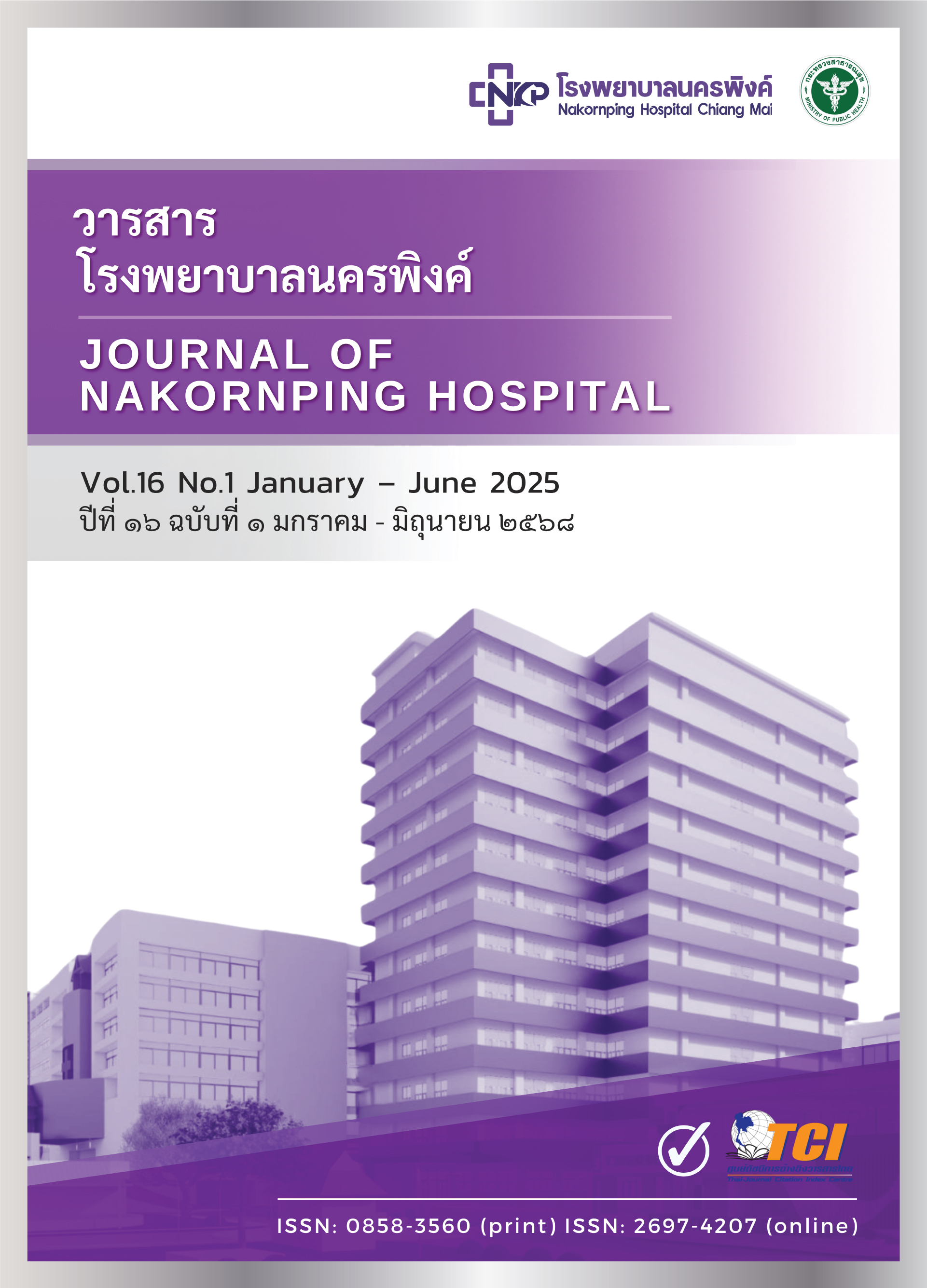Factors associated with sustained prehospital return of spontaneous circulation after out-of-hospital cardiac arrest at Nakornping Hospital
Keywords:
out-of-hospital cardiac arrest, prehospital return of spontaneous circulation, emergency medical services, predictive factors, cardiopulmonary resuscitationAbstract
Introduction: Out-of-hospital cardiac arrest (OHCA) is an emergency medical condition, which needs advanced cardiac life support. However, there has been a lack of consensus to determine the factors related to the outcome.
Objectives: This study aimed to identify the factors associated with sustained prehospital return of spontaneous circulation (sustained PROSC) after OHCA.
Methods: This is a retrospective prognostic study conducted at Nakornping Hospital. Data were collected from the medical records of OHCA patients between January 1, 2020, and December 31, 2023. The inclusion criteria were patients aged 18 years or older who experienced out-of-hospital cardiac arrest, were transported by advanced medical response units, and were later admitted to the emergency department. The exclusion criteria included patients with a do-not-attempt-resuscitation (DNAR) order, individuals whose cardiac arrest resulted from trauma, those who received emergency medical care via air transport (sky doctor), patients showing post-mortem changes from the outset, and individuals treated in the emergency departments of other hospitals. Factors associated with sustained PROSC following OHCA were analyzed using logistic regression. Data analysis was performed using descriptive and logistic regression analysis.
Results: A total of 266 patients were included in the study. The participants had an average age of 64.1 ± 16.9 years. There were 104 patients (39.1%) who had sustained PROSC. Mean response time was 13.3 ± 6.1 minutes. In multivariable analysis age over 60 years (Adjusted Odd Ratio 1.94; 95%CI: 1.05-3.56, p=0.033) and bedridden patients (Adjusted OR: 11.91; 95%CI: 2.58-54.97, p=0.002) were factors associate sustain PROSC.
Conclusion: Age over 60 years and bedridden were significantly associated with sustained PROSC after OHCA. Therefore, the emergency medical system should be adapted and developed effective protocol to handle patients experiencing OHCA and gain the success rates of resuscitation in our hospital.
References
Myat A, Song KJ, Rea T. Out-of-hospital cardiac arrest: current concepts. Lancet. 2018;391(10124):970-9. doi: 10.1016/S0140-6736(18)30472-0.
Sasson C, Rogers MA, Dahl J, Kellermann AL. Predictors of survival from out-of-hospital cardiac arrest: a systematic review and meta-analysis. Circ Cardiovasc Qual Outcomes. 2010;3(1):63-81. doi: 10.1161/CIRCOUTCOMES.109.889576.
Chen HA, Hsu ST, Hsieh MJ, Sim SS, Chu SE, Yang WS, et al. Influence of advanced life support response time on out-of-hospital cardiac arrest patient outcomes in Taipei. PLoS One. 2022;17(4):e0266969. doi: 10.1371/journal.pone.0266969.
Ong ME, Shin SD, De Souza NN, Tanaka H, Nishiuchi T, Song KJ, et al. Outcomes for out-of-hospital cardiac arrests across 7 countries in Asia: The Pan Asian Resuscitation Outcomes Study (PAROS). Resuscitation. 2015;96:100-8. doi: 10.1016/j.resuscitation.2015.07.026.
Perman SM, Elmer J, Maciel CB, Uzendu A, May T, Mumma BE, et al. 2023 American Heart Association Focused Update on Adult Advanced Cardiovascular Life Support: An Update to the American Heart Association Guidelines for Cardiopulmonary Resuscitation and Emergency Cardiovascular Care. Circulation. 2024;149(5):e254-73. doi: 10.1161/CIR.0000000000001194.
Morais DA, Carvalho DV, Correa Ados R. Out-of-hospital cardiac arrest: determinant factors for immediate survival after cardiopulmonary resuscitation. Rev Lat Am Enfermagem. 2014;22(4):562-8. doi: 10.1590/0104-1169.3453.2452.
Blanchard IE, Doig CJ, Hagel BE, Anton AR, Zygun DA, Kortbeek JB, et al. Emergency medical services response time and mortality in an urban setting. Prehosp Emerg Care. 2012;16(1):142-51. doi: 10.3109/10903127.2011.614046.
Viereck S, Palsgaard Møller T, Kjær Ersbøll A, Folke F, Lippert F. Effect of bystander CPR initiation prior to the emergency call on ROSC and 30day survival-An evaluation of 548 emergency calls. Resuscitation. 2017;111:55-61. doi: 10.1016/j.resuscitation.2016.11.020.
Blackwell TH, Kaufman JS. Response time effectiveness: comparison of response time and survival in an urban emergency medical services system. Acad Emerg Med. 2002;9(4):288-95. doi: 10.1111/j.1553-2712.2002.tb01321.x.
Gamberini L, Tartivita CN, Guarnera M, Allegri D, Baroncini S, Scquizzato T, et al. External validation and insights about the calibration of the return of spontaneous circulation after cardiac arrest (RACA) score. Resusc Plus. 2022;10:100225. doi: 10.1016/j.resplu.2022.100225.
Liu N, Liu M, Chen X, Ning Y, Lee JW, Siddiqui FJ, et al. Development and validation of an interpretable prehospital return of spontaneous circulation (P-ROSC) score for patients with out-of-hospital cardiac arrest using machine learning: A retrospective study. EClinicalMedicine. 2022;48:101422. doi: 10.1016/j.eclinm.2022.101422.
Pichedboonkiat P. Survival factors of out-of-hospital cardiac arrest in Chiangrai Prachanukroh Hospital. Chiangrai Medical Journal. 2021;13(1):43-57. [In Thai]
Saengsawang T, Tienpratarn W, Yuksen C. Factor Related to Outcomes of Out-of-Hospital Cardiac Arrest at Emergency Department, Nong Khai Hospital, Thailand. Journal of Emergency Medicial Services of Thailand. 2022;2(1):28-36. [In Thai]
Patsadu P, Pholtana S, Srichan P, Jonglertmontree W. Factor Affecting Survival Outcome among Hospital Cardiac Arrest: a Systematic Review. Journal of Emergency Medical Services of Thailand. 2021;1(2):184-97. [In Thai]
Pemberton K, Franklin RC, Bosley E, Watt K. Pre-hospital predictors of long-term survival from out-of-hospital cardiac arrest. Australas Emerg Care. 2023;26(2):184-92. doi: 10.1016/j.auec.2022.10.006.
Ahn JY, Ryoo HW, Moon S, Jung H, Park J, Lee WK, et al. Prehospital factors associated with out-of-hospital cardiac arrest outcomes in a metropolitan city: a 4-year multicenter study. BMC Emerg Med. 2023;23(1):125. doi: 10.1186/s12873-023-00899-3.
Photipim M, Laohasiriwong W, Thinkhamrop B, Sethasathien A, Hurst C. The effect of response time on survival among non-traumatic out-of-hospital cardiac arrest patients in Thailand. Journal Health Research. 2016;30(1):19-24. [In Thai]
Downloads
Published
How to Cite
Issue
Section
License
Copyright (c) 2025 Nakornping Hospital

This work is licensed under a Creative Commons Attribution-NonCommercial-NoDerivatives 4.0 International License.
The articles that had been published in the journal is copyright of Journal of Nakornping hospital, Chiang Mai.
Contents and comments in the articles in Journal of Nakornping hospital are at owner’s responsibilities that editor team may not totally agree with.


